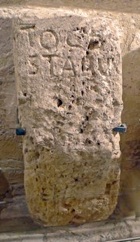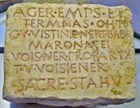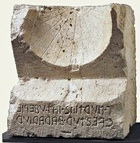

Umbri
Archeological evidence for the Umbrian settlement of Assisi in the Iron Age is scant:
-
✴A number of votive objects and terracottas (6th-1st centuries BC) found in 1979-81 under Ristorante Medioevo in Via Arco dei Priori suggest that an Umbrian sanctuary here was destroyed when the Roman terrace was built in front of the so-called Temple of Minerva in the 1st century BC.
-
✴Bronze votive objects found on Colle San Rufino, a spur on Monte Subasio, suggest that this was a cult site in the 5th century BC.
Umbrian Assisi was probably large enough to have been among the cities that the Romans defeated after the Battle of Sentinum (295 BC). It was probably forced to accept allied status at this point.
After the Roman Conquest
Inscriptions in the Umbrian Language
Figures in square brackets in the headings below refer to the respective entries in the catalogue “Scehrto Est” (referenced below).
Inscriptions from gates in the city Walls [31-2]
The catalogue “Scehrto Est” (referenced below) describes two Umbrian inscriptions that seem to relate to the construction of the walls of the city (see below). Alberto Calderini (at p. 46) dated these inscriptions to the middle of the 3rd century BC:
-
✴The first (ST UM 5, described in Entry 31, by Alberto Calderini and Giulio Giannechini), of which only the right part survives, was from the architrave of a gate in these walls that was discovered in 1938 near the ex-Oratorio di San Lorenzo and is still preserved in the garden of what became the Berkeley Villa. The architrave contains a fragmentary Umbrian inscription that uses an Etruscan alphabet. It has been transcribed:
-
estac vera vaper[ia?]...
-
mestiça vipies ep...
-
The first line seems to confirm that the stone was part of a stone gate (‘vera vaperia’), while the second seems to mean “under the meddix Vibius Ep…”.
-
✴The second (described in Entry 32, by Giulio Giannechini) was discovered near the Abbazia di San Pietro in 1742 but no longer survives. Surviving records suggest that this inscription also recorded the construction of a gate by the meddix Vibius.
As discussed below, the word “meddix” described a magistrate: Alberto Calderini (as above) suggested that the magistrates named in these inscriptions from Assisi might have been the same person or, more probably, two people from the same family.
Cippus (2nd century BC) [43]

“toce stahu”,
which probably means "I stand in a public place".
The cippus is now in the Museo Civico, Assisi.
Umbrian Inscription (late 2nd century BC) [28]
This inscription, which was discovered in the convent of San Damiano in 1982, was embedded in the corner of the cloister below Monte Subasio during the restructuring of the complex in 2001. The inscription, in the Latin alphabet, reads:
ARENTEI O[...]
ASO SACR[...]
The inscription was originally thought to have been in Latin, but the word “aso” is now thought to be the Umbrian word for an altar. Simone Sisani (referenced below, 2007) translated it as:
altar sacred to Arentia O[.....]
where the “O” is an abbreviation of the unknown Umbrian word that equates to the Latin epithet “Obsequens” (as in “Venus Obsequens”, where the epithet is translated into English as compliant, gracious or accommodating). Arentia is otherwise unknown in Italy, but Arentius and his wife Arentia were worshipped in ancient Lusitania (modern Portugal).
Cippus from Bastia (120 - 90 BC) [45]
The cippus was found in 1742 at Ospedalicchio, near Bastia (between Assisi and Perugia) and is now in the Museo Archeologico Nazionale, Perugia. The inscription is one of the longest surviving inscriptions (ST Um 10, CIL XI 5389, 120 - 90 BC) in the Umbrian language and also the oldest known example that uses the Latin alphabet. It reads:

TERMNAS OHT[RETIE]
C V VISTINE NER T BABR[IE]
MARONATEI
VOIS NER PROPARTIE
T V VOISNIER
SACRE STAHU
The inscription refers to a field (ager) that has been bought and delimited (emps et termnas). The final words “sacre stahu” probably imply that the purchase and delimitation of the field had religious significance. It took place during the period of office of:
-
✴the two men who held the post of uhter in the year in question:
-
•C(aius) Vestinius, son of V(ibius) and
-
•Ner(o) Babrius, son of T(itus); and
-
✴the two men who held the post of marone:
-
•Vois(ienus) Propartius, son of Ner(o), who (as Francis Cairns, referenced below, pointed out, at p. 9) is the first historically attested member of the family of the poet Propertius (below); and
-
•T(itus) Voisienus, son of V(ibius).
Nero Babrius, son of Titus had the more junior post of marone in the Latin inscription from San Rufino (above). These two inscriptions probably refer to the same person (rather than to a grandfather and grandson), in which case the inscription from Bastia is presumably of a slightly later date, despite the fact that it is in the Umbrian language. This demonstrates that both Latin and Umbrian were used in public inscriptions in the late 2nd and early 1st centuries BC.
Simone Sisani (referenced below, 2007, at p. 286) placed this inscription from Ospedalicchio in the context of an ethnic revival at this time that is evidenced at Mevania (Bevagna) and Iguvium (Gubbio):
-
“In the late 2nd and early 1st centuries BC, the epigraphic record seems to point to a second flowering in the use of the Umbrian language, which was employed [for example] in four inscriptions from Mevania and in the segment Va-b7 of the Iguvine Tables [from Gubbio]” (my translation).

[-.] p. nurtins.ia.t.ufeřie[r]
cvestur farariur
It thus names two men who served as ‘cvestur farariur’, which seems to mean as ‘quaestors’ whose responsibilities were related in some way to the supply of spelt. Simone Sisani (referenced below, 2012, at p. 422) suggested that:
-
“The unique title [‘cvestur farariur’] finds a perfect parallel in the ‘homons pure dur to eiscurent’ [of the Iguvine Tables, who were] in charge of the collection of the tribute in flour offered by the participating districts during the so-called ‘ceremony of the tenths’, which constituted an expression of political and religious solidarity of the various people that belonged to the [so-called] Iguvine League” (my translation).
He pointed out that this flour was collected from two designated fields (the Ager Tltius and the Ager Casilus). He therefore suggested (at pp. 422-3) that:
-
“ ... the field ... [in ST Um 10] was expressly designated for the cultivation of the sacred spelt offered by Asisium on the occasion of communal ceremonies of the Umbrian League [at Mevania]” (my translation).
It is certainly possible that these two inscriptions (ST Um 8 and 10) were related to each other, and that they represented evidence of the revival of a pre-Roman religious ritual that had been associated with both of the corresponding find spots. However, I see two main difficulties with the further hypothesis that this was one of the well-remembered rituals of an ancient ‘Umbrian league’ that had included (inter alia) tribes that later coalesced at both Mevania and Asisium:
-
✴While there is evidence for an ethnic revival at Mevania, as mentioned above (and discussed in more detail in my page on Mevania after the Roman Conquest), the inscription ST Um 8 from Ospedalicchio constitutes the only surviving evidence for a similar ethnic revival at Asisium. Indeed, all the other surviving epigraphic evidence from Asisium points instead to a precocious ‘Romanisation’ of the city, as discussed above. This does not invalidate the hypothesis of an ethnic revival of some kind in the Valle Umbra, but it does make it difficult to understand the forces that might have caused the people of Asisium to take an active part in it.
-
✴The league described in the Iguvine Tables seems to have involved only the tribes that later coalesced at what became the municipium of Iguvium: indeed, in the Iguvine Tables, the tribes characterised as ‘Tadinates’, who later coalesced at the nearby municipium of Tadinum (now Gualdo Tadino), were listed among the inveterate and hated enemies of the Iguvines. Thus, if the ritual described in these Tables is accepted as a relevant precedent for a similar ritual in the Valle Umbra, the implication would be that the field at Ospedalicchio was remembered as having originally belonged to a tribe associated with what became Mevania, rather than to another autonomous member of an ‘Umbrian League’ that had its centre there.
In short, if ST Um 8 and 10, taken together, are accepted as evidence for the revival of an ancient Umbrian ritual in the Valle Umbra, it is likely that this putative revival took place under the auspices of Mevania, and that Asisium played at most only a peripheral role in it.
Urbanisation before the Social Wars
The historian Filippo Coarelli (referenced below, at pp. 21-2) has coined the phrase “auto-Romanisation” to describe what seems to have been the voluntary adoption of Roman culture at Assisi even before the Social Wars, not least in the Roman approach to city planning. Nevertheless, three cinerary urns in the Museo Civico that probably date to this period exhibit a marked Etruscan influence.
City Walls (2nd half of the 3rd century BC)
Writing in the late 1st century BC, the poet Sextus Propertius remembered “ancient Umbria”, where he had been born, and:
-
“... the wall towers from the summit of climbing Asisium, that wall made more famous by your genius” (‘Elegies’, 4)
These walls (of which large sections survive) ran for some 2.5 km and enclosed some 60 hectares, which indicates that Asisium was only slightly smaller in area that nearby Perusia (Perugia) and was bigger than most other Umbrian cities at this time. In his discussion in the catalogue “Scehrto Est’ (referenced below) of two inscriptions that probably recorded the construction of gates in this wall, Alberto Calderini pointed out (at p. 46) that these walls can be roughly dated to the middle of the 3rd century BC. Guy Bradley (referenced below, at p. 167) observed that they:
-
“... followed a course determined in places by defensive considerations rather than the extent of habitable space. The scale of the wall and the antiquity of its conception has a great significance for this allied town. The immediate motive for the construction of the fortification may have been the renewed sense of danger emphasised by the invasion of Hannibal, who probably passed near Asisium after the battle of Trasimene [of 217 BC].”
Monumental Entrance to the City (2nd century BC)
Filippo Coarelli (referenced below, pp. 9-11) described the remains of a monumental entrance to the city that were discovered in the early 20th century in Piazza Matteotti but subsequently destroyed. Four huge columns discovered in Vicolo Bovi at the same time probably formed part of a portico that led from this gate to the heart of the city. Stones from the city gate have been incorporated into Casa Assunti (1918-26) at number 5 Piazza Matteotti, and the base of one of the columns can be seen in its garden.
Terrace Wall (140 - 100 BC)

Plaster cast of CIL XI 5390 (Museo Civico)
The original survives under the campanile of San Rufino, but is only partially visible
An inscription (CIL XI 5390) over an arch that leads to a Roman cistern that now forms the foundation for the campanile of San Rufino is one of the earliest in Latin to survive in an Umbrian city: the EAGLE database (see the CIL link) dates it to the period of the last 4 decades of the 2nd century BC. The main part of the inscription reads:
murum ab fornice ad circum et fornicem cisternamq(ue)
d(e) s(entaus) s(ententia) faciundum coiravere
This records the building, by order of the municipal senate, of the cistern itself and a terrace wall that apparently extended from the arch (fornix) of the cistern to another arch near the circus (which was in modern Piazza Matteotti). Part of this terrace wall can be seen in the crypt of the earlier church of San Rufino. The inscription also names six marones (magistrates) as a dating device: they presumably held office in pairs in the three years over which the work was carried out:
-
✴Post(umus) Mimisius, son of C(aius);
-
✴T(itus) Mimisius, son of Sert(orius);
-
✴Ner(o) Capidas Rufus, son of C(aius);
-
✴Ner(o) Babrius, son of T(itus);
-
✴C(aius) Capidas, son of T(itus), grandson of C(aius); and
-
✴V(ibius) Volsienus, son of T(itus).
Magistracies before the Social Wars
Meddix
The word “meddix”, which appeared in two inscriptions in the catalogue “Scehrto Est” (referenced below, entries 31-2), was the title of a magistracy that has been recorded in the Oscan-speaking communities to the south of modern Umbria, where it seems to designate a supreme magistrate. These two inscriptions from Asisium represent the only known appearances of this magistracy in an Umbrian inscription. Simone Sisani (referenced below, 2007, at p. 252) pointed out that these records at Asisium are some decades older than all the other known Umbrian records of magistracies. He suggested two possibilities for the significance of the meddix at Asisium in the 3rd century BC:
-
✴it represented an early phase in the development of the administrative structures employed in the region; and/ or
-
✴ it was a quasi-religious position associated with the sacred rites used during the establishment of inviolable boundaries.
Uhteres and Marones
Simone Sisani (referenced below, 2007, at p. 249) deduced from surviving inscriptions that:
-
“The administrative structure of the federated [autonomous] communities of Umbria appears to have been based on a college of four members comprising two pairs of magistrates: the auctores [the more senior]; and the marones” (my translation).
Both of these magistracies are recorded in surviving inscriptions at Asisium (discussed above:
-
✴CIL XI 5390 (140 -100 BC), a Latin inscription that survives in situ in the Duomo, records the building of a cistern and a terrace wall and names six marones, who are usually assumed to have held office in pairs in three consecutive years; and
-
✴ST Um 10, CIL XI 5389 (120 - 90 BC), an inscription that uses the Latin alphabet and was found at Ospedalicchio, near Bastia (between Assisi and Perugia), refers to a piece of land that had been bought and delimited by (or during the year in office of) two named uhteres and two named marones.
Since Nero Babrius was named as a marone in CIL XI 5390 and as a uhter in ST UM 10, we know that both inscriptions record magistrates of Asisium.
Read more:
S. Sisani, “I Rapporti tra Mevania e Hispellum nel Quadro del Paesaggio Sacro della Valle Umbra”,, in
G. Della Fina (Ed.), “Il Fanum Voltumnae e i Santuari Comunitari dell’ Italia Antica”, (2012) Orvieto (pp. 409-64)
L. Agostiniani et al. (Eds), “Screhto Est: Lingua e Scrittura degli Antichi Umbri”, (2011) Città di Castello, Entries 31-2 at pp. 46-9
S. Sisani, “Fenomenologia della Conquista: La Romanizzazione dell' Umbria tra il IV sec. a. C. e la Guerra Sociale”, (2007) Rome
F. Cairns, “Sextus Propertius: The Augustan Elegist”, (2006) Cambridge
G. Bradley, "Ancient Umbria", (2000) Oxford
F. Coarelli, "Assisi Repubblicana: Riflessioni su un Caso di Autoromanizzazione", Atti Accademia Properziana del Subasio, (1991) Assisi
Ancient History: Main Page Municipium of Asisium Quinqueviri and Seviri
Return to the home page on History
Return to the home page on Assisi

